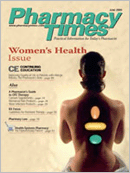Publication
Article
Pharmacy Times
The Hysterectomy Patient
Author(s):
Hysterectomy terminates conditions that disable women with uterine bleeding, pain, and emotional stress. The >600,000 hysterectomies performed in the United States annually place this surgical procedure second only to cesarean section delivery in frequency among women. About one third of American women have had a hysterectomy by age 60; the median age for the surgery is 41 years.1
There are several types of hysterectomy:
- Complete or total hysterectomy, the most common type, removes the cervix and the uterus
- Supracervical hysterectomy (SH; also called partial or subtotal hysterectomy) removes the uterus, leaving the cervix; many experts recommend SH over other types if the cervix is benign, to lend support to pelvic organs in later years2
- Radical hysterectomy removes the uterus, the cervix, the upper vagina, and supporting tissues
Sometimes, surgeons remove 1 or both ovaries and fallopian tubes (salpingo-oophorectomy). Removal of both ovaries in premenopausal women abruptly precipitates menopause. Symptoms can be more severe than with natural menopause.
Reasons for Hysterectomy
Surgeons perform approximately 30% of hysterectomies to address benign uterine fibroids (leiomyomas).3,4 African American women experience fibroids 2 to 3 times more often than white women do. Obesity or menarche before age 12 prolongs estrogen exposure, increasing the risk of fibroids. Nulliparous women are at greater risk than parous women.5 Fibroids increase in size and frequency with age, fueled by estrogen, progesterone, insulin-like and epidermal growth factors, and transforming growth factorbeta.6 Inevitably, these fibroids shrink postmenopausally.7,8
Most fibroids are relatively slow-growing and asymptomatic; symptoms are related to fibroid size, location, and number. Historically, surgeons considered hysterectomy if a woman's uterus exceeded the size of 12 weeks' gestation (280 g). Today, uterine size alone is not an indication without symptoms.9 Fibroids can cause abnormal bleeding or prolonged, heavy menstruation, producing anemia. Fibroid growth can compress neighboring organs, causing pelvic pain or pressure, pain during sexual intercourse, reduced urinary capacity, constipation, and infertility or late miscarriages.6
Endometriosis, most common in nulliparous women between ages 30 and 50, accounts for 20% of hysterectomies.10 Tissue similar to the endometrium coats reproductive organs, the bladder, the intestines, and the rectum and responds to monthly hormonal stimulation. Internal (peritoneal) bleeding, inflammation, and scar tissue formation can distort internal anatomy. Symptoms may include pelvic pain associated with or without bowel movement, urination, menstruation, and sexual intercourse. Infertility or miscarriage also can occur.11
Gynecologists can remove patches of endometrial tissue using a laparoscope or via laparotomy. Hysterectomy is reserved for treatment failures but may miss some endometrial tissue. If the ovaries remain, overlooked tissue may continue to cause problems.11
Uterine prolapse due to weakened pelvic ligaments and tissues leads to ~15% of hysterectomies. Childbirth, obesity, and estrogen loss after menopause may be risk factors for uterine prolapse. Symptoms, depending on prolapse severity, may include vaginal heaviness and pressure; urinary leakage aggravated by heavy lifting, coughing, laughing, or sneezing; urinary tract infections; and sexual problems.10 If estrogen therapy, exercises to strengthen pelvic floor muscles, or pessaries fail, surgery can realign the prolapsed uterus, but hysterectomy may be warranted.
Cancers (endometrial, cervical, ovarian, or uterine sarcoma) account for ~10% of all hysterectomies with or without radiation or hormonal therapy.4 The remaining causes generally involve excessive bleeding or pain.
Hysterectomy is preferred for many pelvic pathologies, but clinicians usually try nonsurgical alternatives first in elective cases (Table 1). A recent study confirms, however, that, compared with medical treatment, women with uterine bleeding who undergo hysterectomy have a better quality of life, greater symptom resolution, and better sexual function for at least 2 years.12 Researchers also have found that 42% of women treated with hormone- releasing intrauterine systems progress to have hysterectomies.13
The Procedure
Several procedures are used to perform hysterectomies-abdominal, vaginal, or laparoscopy-assisted vaginal hysterectomy-with the surgeon's choice depending on the reason for the hysterectomy.
Abdominal hysterectomies account for 60% of US procedures; they usually require a longer recovery time than vaginal hysterectomies.14
Vaginal procedures require more surgical time, but less recovery time. Meta-analysis suggests the use of the vaginal procedure whenever it is technically feasible and finds no benefit to laparoscopy-assisted hysterectomy.15
Complications may include reactions to anesthetics, pain, infection, excessive bleeding, or fatigue. Injury to other pelvic organs (bladder, ureters, or bowel) can occur. Urinary incontinence may occur postoperatively or in later years. Many women fear loss of libido, but most resume sexual activity in 6 weeks and report unchanged or improved sexual function.16
Pharmacist Counseling After Hysterectomy
Pharmacists can expect patients' questions to reflect the type of hysterectomy they had. The use of hormone replacement therapy (HRT) will be an issue for women whose ovaries have been removed. Patients may be familiar with the Women's Health Initiative finding that the risk of cardiovascular events and invasive breast cancer increases after 5.2 years of HRT.17 Pharmacists should support short-term HRT use in women who have unremitting menopause symptoms or are undergoing premature menopause.13
Women will need analgesics for several days after the procedure. Those who have had long-term bleeding or bleeding during surgery may need iron supplements. Table 2 lists some organizations where patients can find information.
A Final Word
An estimated 10 million American women who have had a total hysterectomy continue to have Pap tests needlessly. Patients should be advised to discuss Pap tests with their physicians. Women whose cervix has been removed need Pap tests only if the cervix was cancerous or precancerous; the tissue at the vaginal tunnel's end, however, is similar to cervix tissue and must be tested. Women who undergo total hysterectomy for benign disease do not need Pap tests.18
Ms. Wick is a senior clinical research pharmacist at the National Cancer Institute, National Institutes of Health. The views expressed are those of the author and not those of any governmental agency.
For a list of references, send a stamped, self-addressed envelope to: References Department, Attn. A. Stahl, Pharmacy Times, 241 Forsgate Drive, Jamesburg, NJ 08831; or send an e-mail request to: [email protected].







